What is happening with F1-All Countries?
The story of F1-All Countries is shared by many other family preferences. It is a story of Visa Bulletin dates advancing at a rapid pace during a Covid-19 pandemic, when Interviews were simply not taking place. To understand this, let’s compare the advancement of the ‘Final Action Date’ of the Visa Bulletin from October 2020 to September 2021 ( in RED) with the average of the decade prior (2010 – 2019, in GREEN), and the 2000’s (2000 – 2009).
Essentially, it is like nothing was happening: the dates advanced as much during these two (fiscal) years as they did on average during the last decade. If you look deeper, you can even see that the advancement of the F1-All Countries dates from April 2020 to September 2020 was crazy steep. It is actually the fastest advancement of F1 on record, putting Fiscal Year 2020 as the second best of the last 20 years!
The consequences of that are easy to understand: the dates are way ahead of where they should be, and they are going to have to stay still for a while so that Interviews take place, Green Cards are issued, and dates can start moving forward again.
What will it take for that to happen? Well, we need Interviews at U.S. Consulates and Embassies (called ‘posts’) to take place again. Most of F1 Applicants (~90% or more) are getting their Green Cards through ‘Consular Processing’, so what happens with applicants going through ‘Adjustment of Status’ (and having an Interview at a USCIS Field Office inside the United States) does not have much of an impact.
The following graph is based on U.S. Department of State data. Immigration Planner analyzed thousands of data points corresponding with ‘posts’ operations since October 2018. This enables the aggregation of data coming from more than 150 posts and gives us a precise and unique perspective into what is going on (those who want to see the kind of reports we had to work with can take a look at the original data here). The good news, is that we are definitely trending in the right direction.
As you can see the drop was incredibly abrupt. The State Department went from issuing almost 1,400 Green Cards per month in February 2020 to less than 10 in April 2020!
But you can also note that significant progress has been made. This is especially true since the summer of 2021: the 1,000/month barrier was broken in July 2021 and the 1,500/month barrier in September 2021.
So how far are we in the recovery? We would say we are about 90% of the way back. In order to make that estimation, we compared the average number of Green Card issued during the last full government ‘fiscal year’ before the pandemic (between October 2018 and September 2019) with where we are today (the last 3 months of known data). And this is what we found:
It is worth noting that F1 is a bit behind the average of family preferences (which also includes F2A, F2B, F3, and F4), but not in an alarming way. We pay close attention to this because both USCIS and the U.S. State Department have had to do a lot of ‘prioritization’ of their case load (deciding who gets to be processed first with the limited resources that they have), and we can infer from these numbers what their priorities have been. In summary, F1 did not get as much priority as F2A (spouses and children of legal permanent residents) did, but it was not heavily penalized either.
When talking to other applicants, also make sure that you are not comparing yourself with ‘immediate relatives’ of U.S. Citizens. Clear priority was given by the State Department to immediate relatives, so their situation is generally much better and their wait much shorter. If you want to assess the wait at your U.S. Embassy or Consulate, see what is happening with applicants in the F1 category there. If you do not know F1 applicants, see what happens to other ‘preference’ applicants that are not F2A and/or join the Immigration Planner Facebook group where updates about consulates are shared on a regular basis.
How did the Final Action Date move in the past few months?
F1 | Latest |
|---|---|
| Visa Bulletin Date: | Oct 2022 |
| Chargeability: | allCountries |
| Final Action Date: | Dec 1, 2014 |
| Movement: | None |
October 2022 and the beginning of the new Fiscal Year did not yield any advancement for F1-All Countries, as expected. The backlog created by the rapidly moving Visa Bulletin dates during the Covid-19 pandemic when Interviews were simply not taking place is obviously not cleared. Because the 'lost' Green Cards of the last 2 years are not coming back, expect 'time-to-current' to go up. |
|---|
See F1 Mexico and the Philippines.
F1 | Last Six | |
|---|---|---|
Visa Bulletin | Final Action | Movement |
| Oct 2022 | Dec 1, 2014 | None |
| Sep 2022 | Dec 1, 2014 | None |
| Aug 2022 | Dec 1, 2014 | None |
| Jul 2022 | Dec 1, 2014 | None |
| Jun 2022 | Dec 1, 2014 | None |
| May 2022 | Dec 1, 2014 | None |
What does Immigration Planner predict?
The key of our prediction is that there will be no ‘forward movement’ for F1-All Countries until at least the summer of 2022, and most likely no movement until the end of fiscal year 2022 in September 2022. Beyond the detailed analysis that we shared, this has been stated numerous times by Charlie Oppenheim, who is the head of the ‘Visa Office’ that makes the decision about the Visa Bulletin (you can listen to him talking about the family preferences in November 2021 at on this Youtube video). At this point we are keeping the door open for the summer, but unless we see another jump in consular processing soon, we will update our prediction and extend the stagnation.
F1, All Countries – Final Action Dates Predictions for the next two years:
You are going to have to use our web app to get longer terms predictions (which is free, and it takes only a few minutes to get results), but this will give you a sense of where we see things going in the short term –>
Latest predictions of Immigration Planner for the Final Action Dates of F1 for 🌐All Countries.
Children of U.S. Citizens who are adults, but not married.
Visa Bulletin | Final Action |
|---|---|
| Oct 2022 | Jan 1, 2015 |
| Nov 2022 | Jan 8, 2015 |
| Dec 2022 | Feb 8, 2015 |
| Jan 2023 | Mar 8, 2015 |
| Feb 2023 | Apr 8, 2015 |
| Mar 2023 | May 1, 2015 |
| Apr 2023 | Jun 1, 2015 |
| May 2023 | Jul 1, 2015 |
| Jun 2023 | Aug 1, 2015 |
| Jul 2023 | Sep 1, 2015 |
| Aug 2023 | Sep 22, 2015 |
| Sep 2023 | Oct 22, 2015 |
| Oct 2023 | Nov 15, 2015 |
| Nov 2023 | Dec 1, 2015 |
| Dec 2023 | Dec 22, 2015 |
| Jan 2024 | Jan 8, 2016 |
| Feb 2024 | Feb 1, 2016 |
| Mar 2024 | Feb 15, 2016 |
| Apr 2024 | Mar 8, 2016 |
| May 2024 | Mar 22, 2016 |
| Jun 2024 | Apr 15, 2016 |
| Jul 2024 | May 1, 2016 |
| Aug 2024 | May 22, 2016 |
| Sep 2024 | Jun 8, 2016 |
| Oct 2024 | Jul 1, 2016 |
| Nov 2024 | Jul 15, 2016 |
| Dec 2024 | Aug 8, 2016 |
| Jan 2025 | Aug 22, 2016 |
| Feb 2025 | Sep 15, 2016 |
| Mar 2025 | Oct 1, 2016 |
| Apr 2025 | Oct 22, 2016 |
| May 2025 | Nov 8, 2016 |
| Jun 2025 | Dec 1, 2016 |
| Jul 2025 | Dec 15, 2016 |
| Aug 2025 | Jan 8, 2017 |
| Sep 2025 | Jan 22, 2017 |
Don’t see your Priority Date? Want to know when your Interview will take place? Get a detailed, personalized Timeline with Date Predictions for each step.
What can we say about ‘time to current’?
Time to current measures the time it takes an applicant to have their ‘priority date’ current when compared to the ‘final action date’ of the Visa Bulletin. Although not factually correct, time to current is often used by applicants as an estimation of how long it is going to take them to get their Green Card. We also make predictions about time to current for our Green Card dynamic timeline predictions: the process of scheduling a Green Card interview cannot be initiated before the applicant’s date is ‘current’, so it is one of the key ‘anchor’ of the process.
Before the pandemic, all was not perfect, but the general trend was heading in the right direction:
The incredibly sad news however is that family Green Cards that were not issued over the last two years are gone forever. They are not coming back for family (they were transferred to ’employment’ based Green Cards). As a result, time to current will go up and we see a stabilization around 8.5 years.
Should applicants ‘opt-out’ of F1?
A lot of F1 applicants were F1 from the beginning (they were sponsored by a U.S. parent), and this question does not apply to them. But there is another ‘way’ to get to F1: applicants who were originally sponsored by their Green Card parent, and see their parent naturalize and obtain U.S. citizenship. These applicants have the option to ‘switch’ from F2B to F1, or they can ‘opt-out’ and stay F2B.
This section applies to these F2B applicants whose parent naturalized and wonder whether they should stay F2B or move to F1.
The following graph represents F1 minus F2B. If F1 minus F2B yields a positive number, then it means that the Final Action Date for F1 is ahead of the F2B one, which is good for applicants (the Interview can be scheduled sooner), which in turn means that applicants should welcome a move to F1.
If the number is negative, the opposite is true: F2B is ahead of F1, which means that staying put in F2B would be the apparent ‘best’ choice.
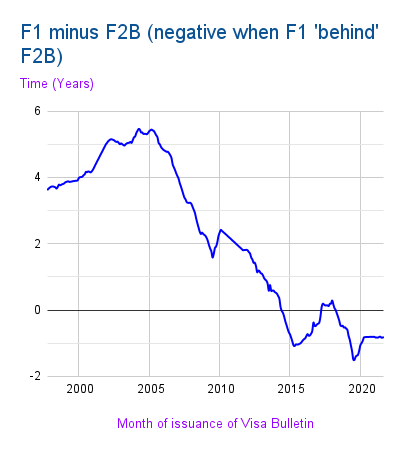
Question | Answer |
|---|---|
| Does F1 have an advantage over F2B? | No |
| Should applicants 'opt-out' of F1? | Yes |
| Where is F1 compared to F2B (in Months)? | -9.8 |
| Last update? | October 2022 |
Switching to F1 used to be an obvious choice. For the last few years however, ‘opting-out’ and staying in F2B has been the way to go.
I am going through adjustment of status, what else applies to me?
Applicants going through Adjustment of Status are often allowed to use the ‘Filing Date’ of the Visa Bulletin to determine when they are allowed to file Form I-485. This does not concern many F1 applicants, the overwhelming majority go through Consular Processing (and need to receive the ‘Welcome Letter’ from the National Visa Center in order to be able to file). Here is the latest for Adjustment applicants:
Filing Date | Movement | Status |
|---|---|---|
| Aug 8, 2016 | None | ✔︎ Yes, the Filing Date can be used |
When will the Interview be scheduled?
The process of scheduling the interview is initiated by U.S. immigration agencies when the following two requirements are met:
- The applicant’s Priority Date is ‘current’ when compared to the relevant ‘Final Action Date’
- The applicant’s Green Card Case is ‘interview-ready’ (also called ‘case complete’ or ‘documentarily qualified’, meaning that all the proper Forms, Evidence, and Fees necessary to make a decision on the Green Card Application have been received by U.S. Immigration Agencies).
Being ‘current’ means that the applicant’s Priority Date (which is when Form I-130 was filed) is ‘earlier’ than the relevant Final Action Date. If the relevant Final Action Date is January 1st 2018, then applicants with a Priority Date ‘earlier’ (that is up to December 31st 2016) are said to be current.
The relevant Final Action Date refers to the Final Action Date that applies to applicants based on their preference classification (F1, F2A, F2B, F3, F4) and countries of birth (Mexico, All Countries, …).
The month when the applicant’s Priority Date is current, U.S. Immigration agencies look for an available Interview slot in the month after next (if the applicant’s priority date becomes current in January, then they will start looking for slots in March). How long applicants wait depend on how busy the U.S. Consulate or USCIS Field office is.
When will Immigration Planner update its predictions?
We expect to update our predictions the day after the next Visa Bulletin is released. Our best guess as to when we will update these predictions is as follows:
Oct 15, 2022 |
|---|
Get Your TimelineYour Plan, Instructions, Forms (including Affidavit of Support)
Get your personalized Green Card Plan, detailed instructions, and online USCIS Forms (including Affidavit of Support Form I-864EZ, and Medical Form I-693) with automatic error detection.
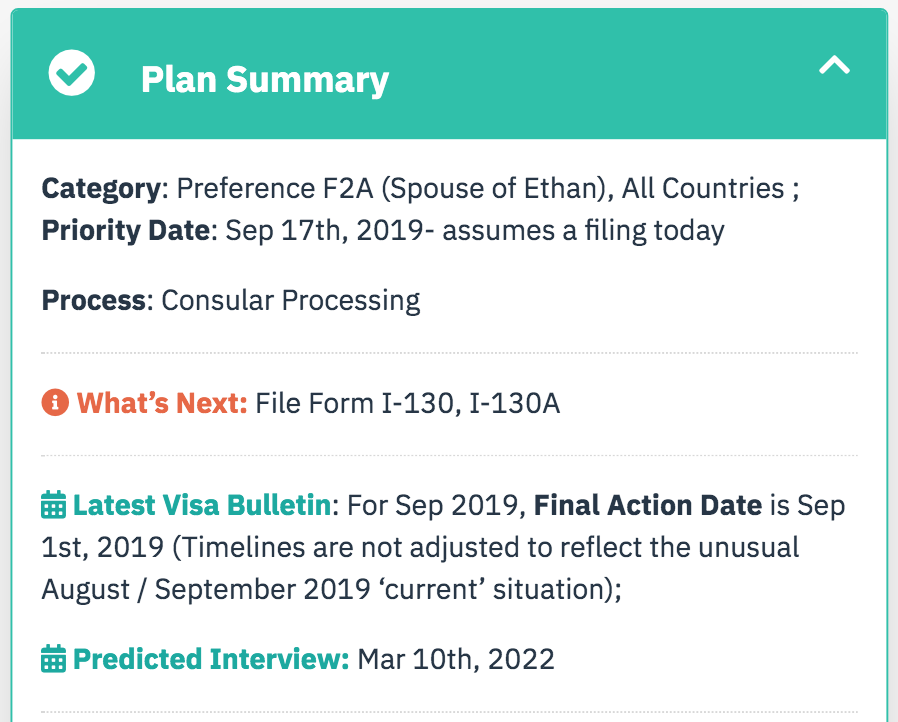
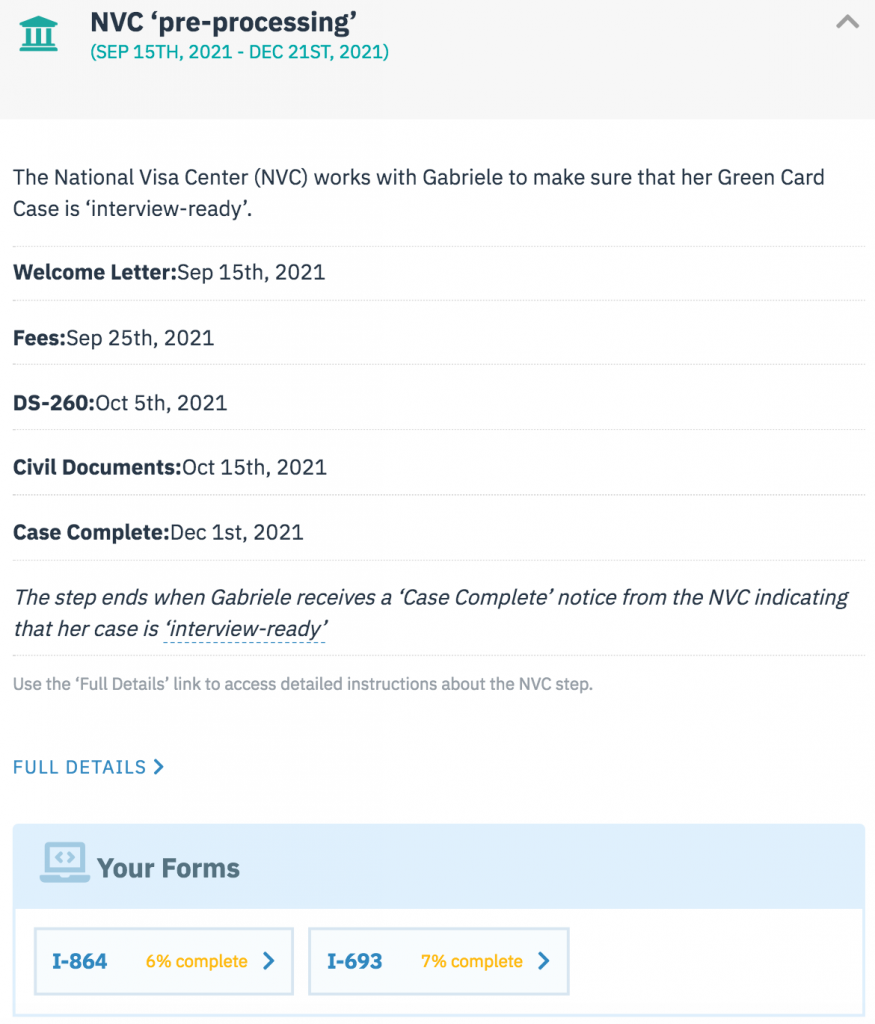
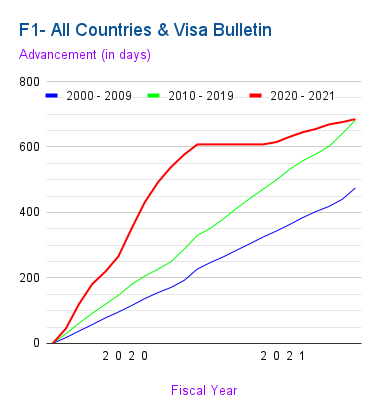
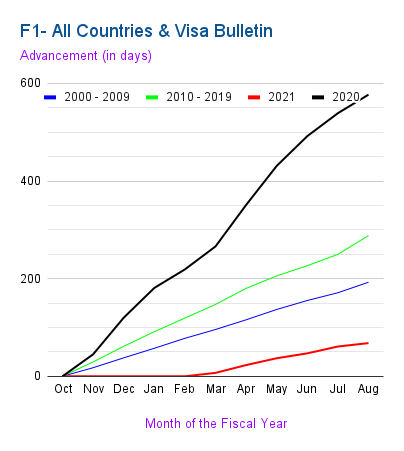
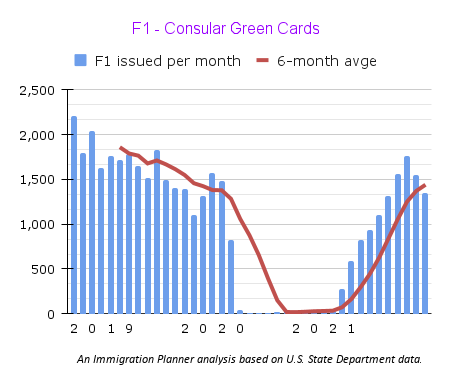

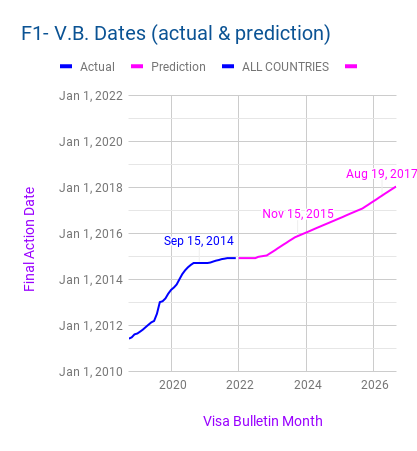
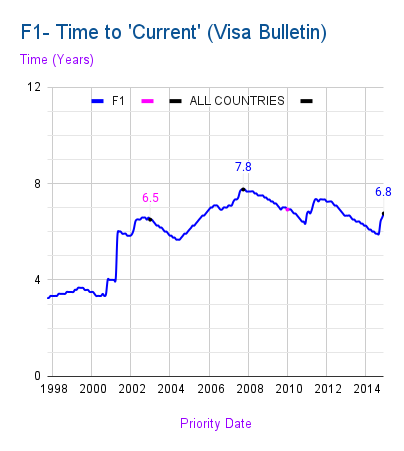
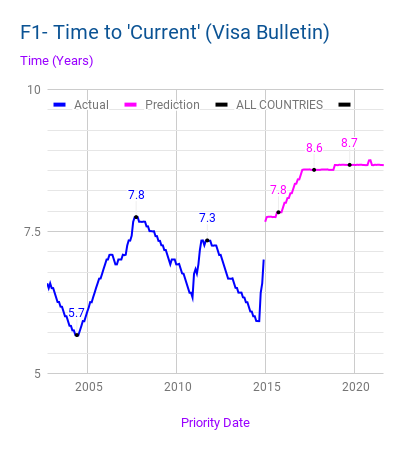
 All Countries Visa Bulletin
All Countries Visa Bulletin F4-India
F4-India